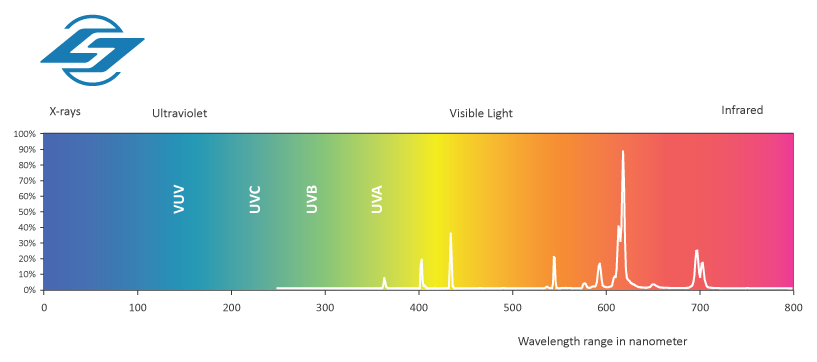Uvc Light - The Facts
Uvc Light - The Facts
Blog Article
The Facts About Uvc Light Revealed
Table of ContentsThe Uvc Light PDFsThe Facts About Uvc Light RevealedThe Ultimate Guide To Uvc LightGetting My Uvc Light To WorkLittle Known Questions About Uvc Light.Uvc Light Fundamentals Explained
A new sort of ultraviolet light that might be safe for individuals took much less than five minutes to lower the level of indoor air-borne microbes by more than 98%, a joint research by researchers at Columbia University Vagelos College of Physicians and Surgeons and in the U.K. has actually found. Even as microorganisms remained to be sprayed into the space, the degree remained very low as lengthy as the lights got on.Till currently these research studies had only been conducted in tiny experimental chambers, not in full-sized rooms simulating real-world problems. In the current study, scientists at the University of St. Andrews, University of Dundee, University of Leeds, and Columbia University evaluated the effectiveness of far-UVC light in a big room-sized chamber with the exact same air flow price as a normal office or home (concerning three air modifications per hour).
The efficiency of various strategies to lowering interior infection degrees is normally determined in regards to comparable air modifications per hour. In this research study, far-UVC lamps produced the equivalent of 184 equivalent air exchanges per hour. This surpasses any various other method to sanitizing occupied indoor spaces, where 5 to 20 comparable air modifications per hour is the finest that can be accomplished practically.
The 20-Second Trick For Uvc Light

The major specifications of UV-C disinfection are wavelength, dose, relative moisture, and temperature level. There is no agreement about their optimal values, but, generally, light at a high dosage and a spectrum of wavelengths consisting of 260 nm is liked in a setting at room temperature with low loved one moisture. This light can be produced by mercury-vapour, light-emitting diode (LED), pulsed-xenon, or excimer lamps.
Additionally, there are health and wellness risks connected with the UV-C innovation when used in the closeness of individuals. UV-C disinfection systems have encouraging functions and the possible to enhance in the future. Clarifications bordering the various specifications affecting the innovations' performance in medical facility setting are needed. UV-C sanitation need to currently be thought about for low-level rather than top-level sanitation.
One more application occurred in 1910 when UV light was utilized to sanitize water. Nowadays, UV light is used for water, air, food, surface, and clinical tools sanitation.
The Single Strategy To Use For Uvc Light
This results in the disruption of DNA or RNA, leading to the inactivation of the micro-organism. UV-C-induced DNA disturbance frequently is composed of the bonding of two adjoining thymine (or cytosine) bases rather of the traditional connecting of a base with its complementary base on the various other hair.

The UV-C zone is made use of for disinfection yet there is no agreement on the specific optimal wavelength. Light at 260 nm can cause the most disturbance. Various micro-organisms are most susceptible to somewhat different wavelengths.
9 Simple Techniques For Uvc Light
It even has a fringe benefit by lowering photoreactivation via a reduction of photolyase [9] On the other hand, it has technical effects given that the complete energy of the beam is then divided over all existing wavelengths. Consequently, a micro-organism that is prone to 254 nm light will be inactivated extra by a light that discharges exclusively light at 254 nm than a lamp try this out that gives off a wavelength range at equivalent total power.
Exposure times of 1045 minutes for area disinfection and 25 s to 5 minutes for clinical devices were run into in literature. The strength is vice versa proportional to the made even distance between the source of light and the surface area and is for that reason specified at the surface in the dose estimation equation [14]
Better, the output of a lamp decreases with time, so it is recommended to compute the dosage at the end of light life, which is agent of a other worst-case circumstance. The dose additionally affects the quantity of photoreactivation. Quek et al. found that the percentage of photoreactivation lowered from 5.31% to 0% for a boost in dosage from 1.6 to 19.7 mJ/cm2 [8]
Zhang et al. observed a modification in UV irradiance of 34% when the RH boosted from 50% to 90% [18] The quantity of RH influence on UV effectiveness depends upon the here and now micro-organism and is a lot more evident for microorganisms than for infections [16] Last but not least, the impact of temperature level depends upon the source of light.
Fascination About Uvc Light


This is understood as far UV-C innovation and is a relatively new sanitation approach with restricted understanding about its effectiveness. This makes it riskier to entirely count on this innovation for disinfection in the hospital and it is therefore not extensively made use of [21] Nonetheless, it likewise has benefits such as a reduced threat for use near people as a result of a lower infiltration deepness into the skin and eyes [ 26]
In study, the results on pulsed versus continual UV-C disinfection performance vary. When contrasting pulsed and constant light it is essential to maintain other variables such as wavelength and dose consistent. Nyangaresi et al. and Sholtes et al. both located that pulsed or continuous light discharged by LEDs brought about similar log10 decreases [15,28]
The 20-Second Trick For Uvc Light
In instance ozone is not required for disinfection, a changed lamp can be utilized. For mercury-vapour lights, look what i found drugged quartz glass or specialized soft glass can remove short-wave UV-C light. For pulsed-xenon, drugged quartz can be made use of as well [30] UV-C has promising features for disinfection such as automatic disinfection, being much less taxing than commonly made use of manual or chemical sanitations, leaving no dangerous residuals, and being eco friendly (if no mercury-vapour lights are utilized) [31,32]
Report this page